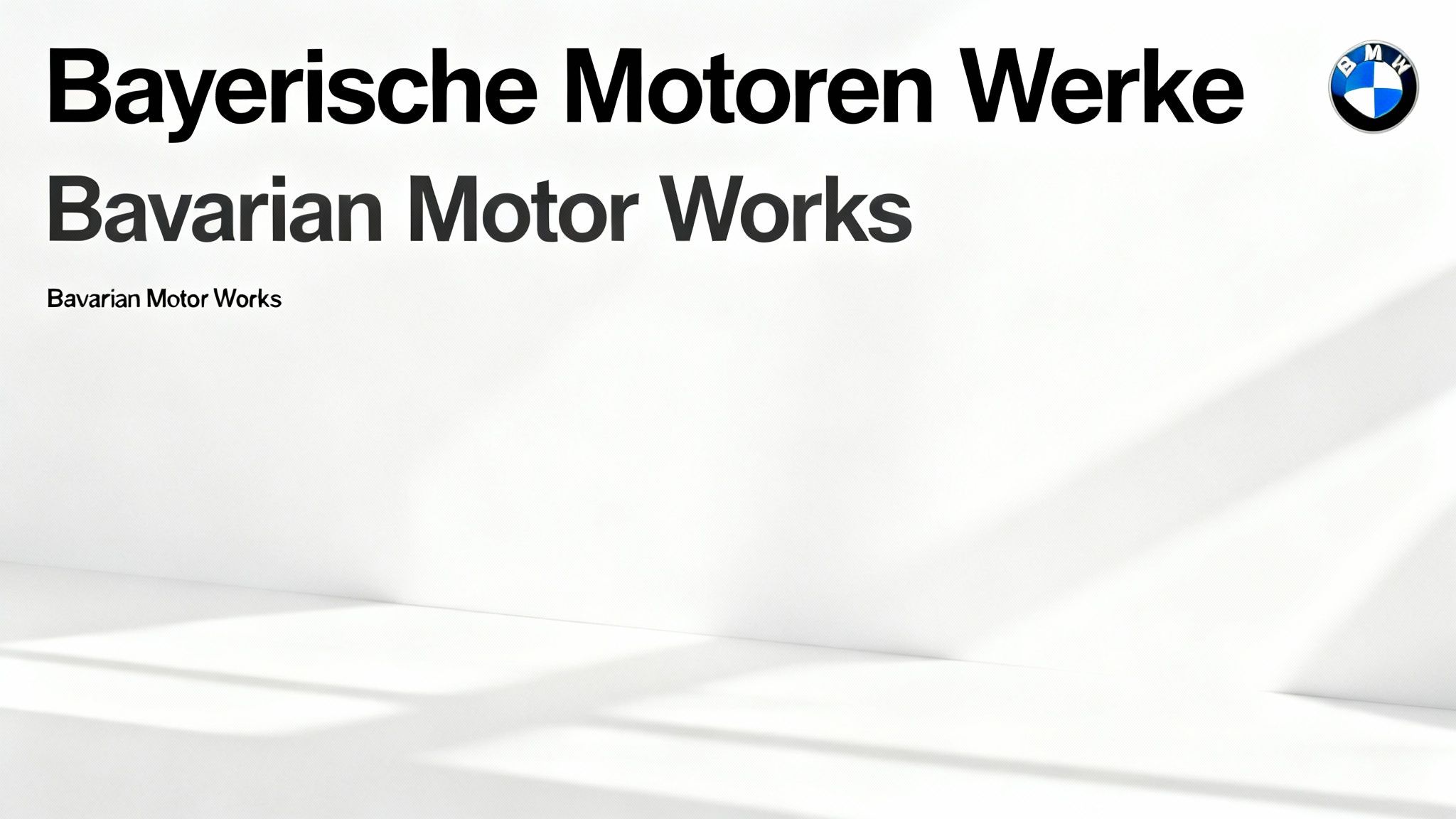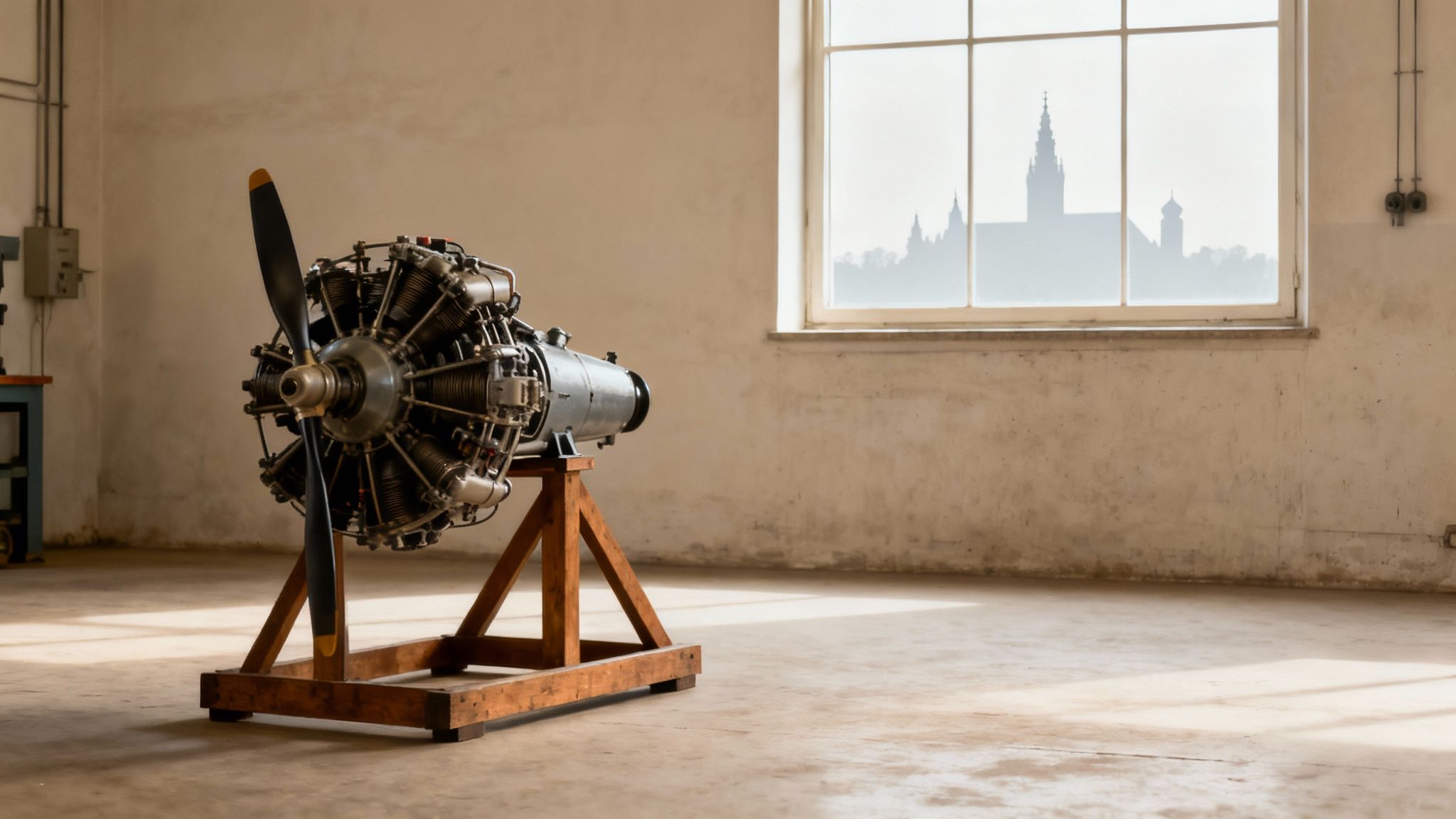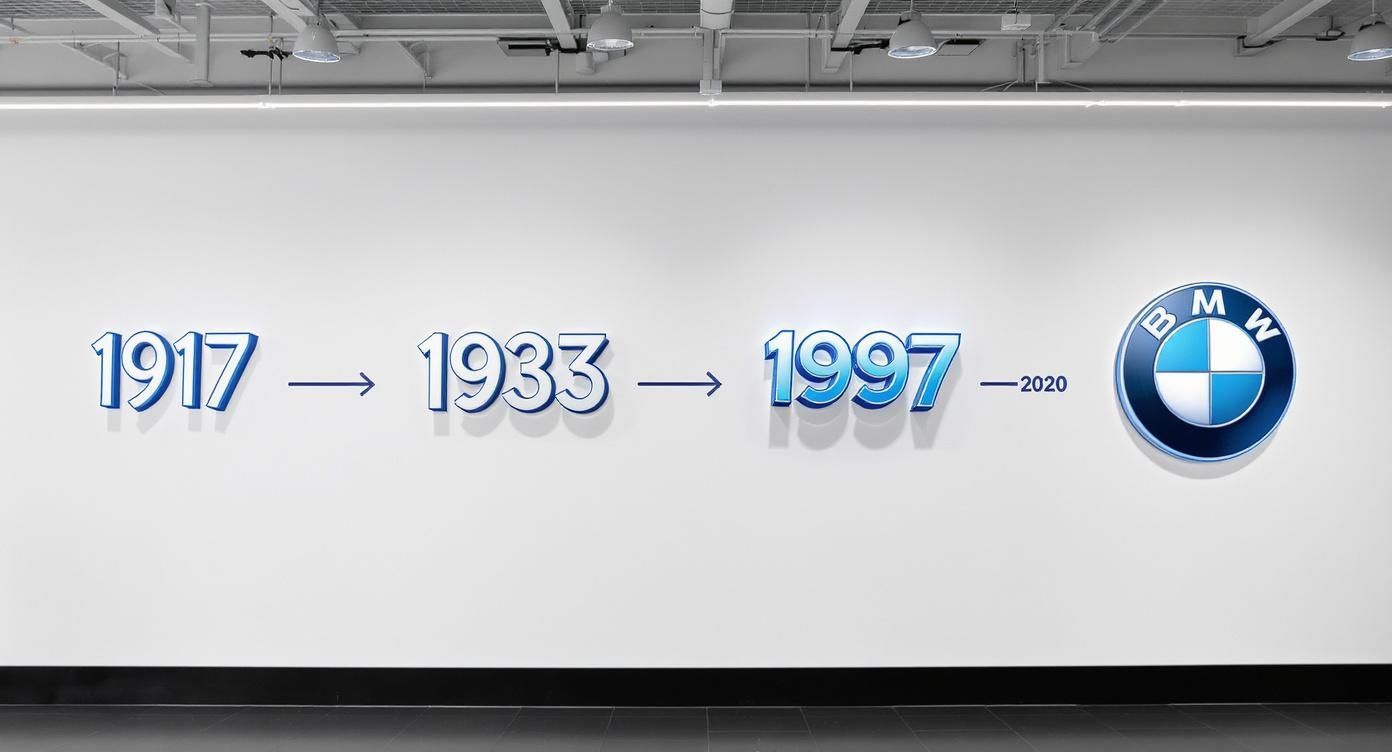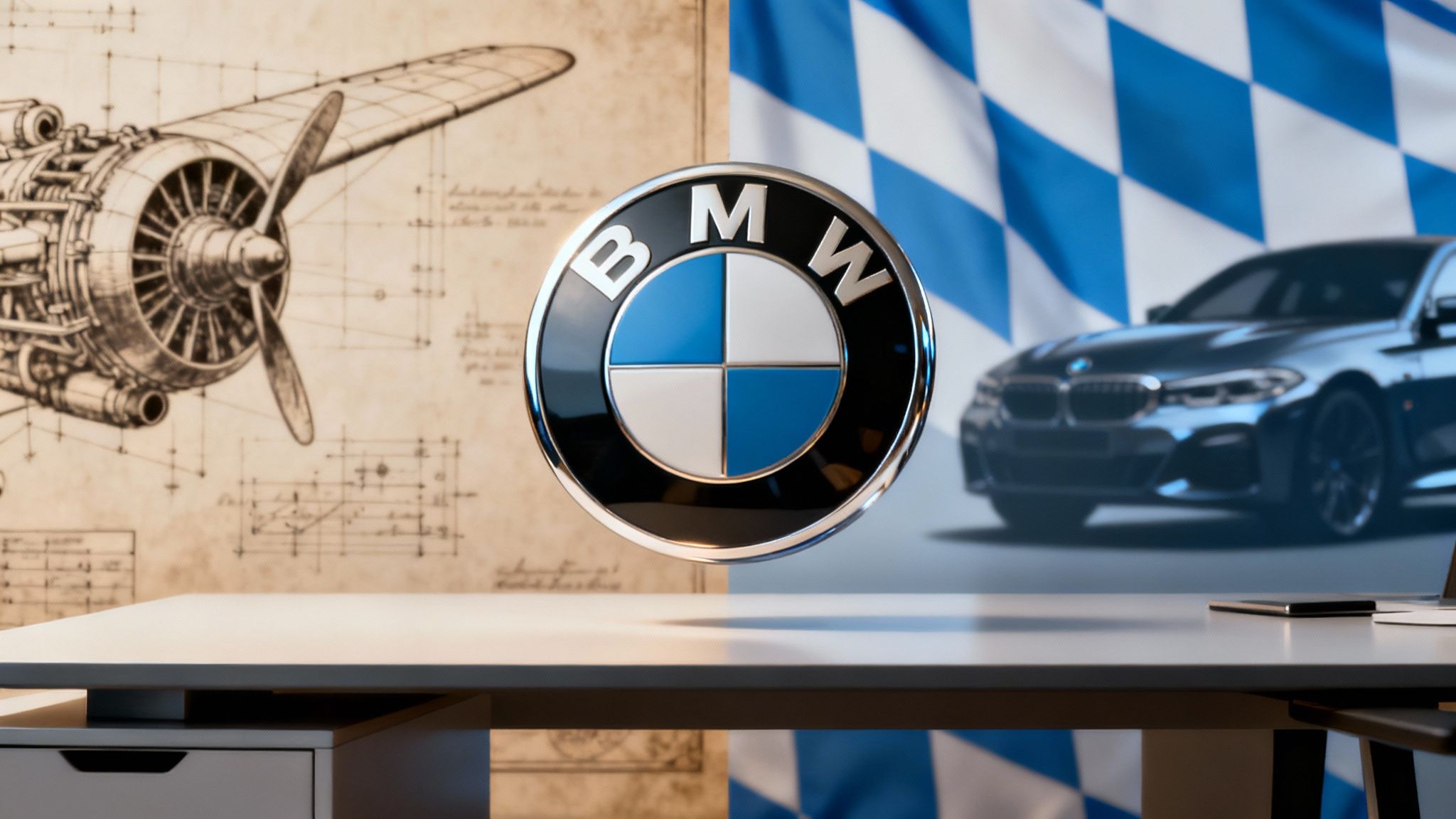Many are familiar with the three letters, but what does BMW actually stand for? The acronym is not an abstract concept, but a direct reference to the company’s origins. The name stands for Bayerische Motoren Werke.
In English, this translates to Bavarian Motor Works. The name is a clear declaration of the company’s origin and original purpose, grounding the brand in a specific location and craft from its inception.
The Story Behind the Name

The name Bayerische Motoren Werke provides insight into the company’s provenance. Let’s examine each component:
- Bayerische: This means “Bavarian” and points directly to its home in the German state of Bavaria, a region known for its engineering talent and precision.
- Motoren: This is the German word for “motors” or “engines.” Before manufacturing the vehicles known today, BMW was an acclaimed manufacturer of aircraft engines. That legacy of high-performance engineering is embedded in its name.
- Werke: This translates to “Works,” a traditional term for a factory or plant.
Combined, these elements form a clear picture: a motor manufacturing company originating in Bavaria.
The name BMW is more than a label; it is a mission statement. It conveys a profound pride in the Bavarian engineering heritage that has defined the brand since its beginning.
Before delving into BMW’s evolution from an engine manufacturer to a globally recognized automotive symbol, it is helpful to understand the name’s pronunciation.
Here is a guide to understanding and pronouncing the full German name.
BMW Acronym Breakdown
| Term | German | English Translation | Pronunciation Guide |
|---|---|---|---|
| BMW | Bayerische Motoren Werke | Bavarian Motor Works | Bay-er-ish-uh Moh-tor-en Verk-uh |
| Bayerische | Bayerische | Bavarian | Bay-er-ish-uh |
| Motoren | Motoren | Motors / Engines | Moh-tor-en |
| Werke | Werke | Works / Plant | Verk-uh |
With the name demystified, one can see how it established the foundation for the brand’s future.
What Does Bayerische Motoren Werke Actually Mean?

Prior to becoming known as the “ultimate driving machine,” BMW’s focus was on aviation. The name Bayerische Motoren Werke is a direct acknowledgment of the company’s roots in German aviation. To fully appreciate the brand, one must look back to its formation as a merger between two Munich-based aircraft engine manufacturers.
The story begins with two pioneers in early aviation: Rapp Motorenwerke and Bayerische Flugzeugwerke AG (BFW). These were not automotive companies; they were specialists in high-performance engines, and their combined expertise created the foundation for BMW’s focus on precision engineering. The name itself reflects this history—a “Motor Works” proudly based in the German state of Bavaria.
The company as it is known today officially traces its origins to March 7, 1916, when Bayerische Flugzeugwerke AG was founded. However, the recognizable name emerged through subsequent developments. Rapp Motorenwerke was renamed Bayerische Motoren Werke in 1917, and the final component was established in 1922 when BFW acquired the engine works and the brand name. This history explains why a company now synonymous with luxury cars began with an aviation focus.
A Legacy Born from Performance
The brand’s initial mission was not to build luxury sedans, but to manufacture powerful, reliable engines for aircraft. This required every component to perform flawlessly under immense stress, a philosophy that became ingrained in the company’s DNA.
The transition from aircraft engines to automobiles was not a departure from its core identity—it was the application of that same expertise to a different machine. The precision required at 10,000 feet was transferred to the road.
This deep-seated commitment to engineering is a common trait among Germany’s legendary automotive brands. For a different but equally compelling look at how these industrial giants were formed, one can explore the story of Mercedes-Benz. Examining these histories side-by-side reveals a shared culture of innovation that redefined the luxury car market.
What’s the Story Behind the Famous BMW Roundel Logo?
Just as the name Bayerische Motoren Werke anchors the brand to its German homeland, the iconic roundel logo is a direct acknowledgment of its Bavarian roots. For years, a persistent myth—originating from a 1929 BMW advertisement—claimed the blue-and-white circle represents a spinning airplane propeller. While it is an compelling story that connects to BMW’s aviation history, the actual origin is more direct.
The logo is, in fact, a tribute to the state of Bavaria. The checkered blue and white quadrants are the official colors of the Bavarian flag, providing a visual complement to the “Bayerische” (Bavarian) in the company’s name. First registered in 1917, the logo’s core design has remained largely unchanged for over a century, making it one of the most recognized symbols on the road.
From the beginning, that simple design was a powerful statement about the company’s origins and the quality it represented.
The Enduring Propeller Myth
The propeller concept originated with BMW’s own marketing department. To generate interest in a new aircraft engine, they created an advertisement that showed the BMW roundel superimposed over a spinning propeller. The image was so effective that the story gained traction and has persisted ever since.
Although the propeller story is a memorable piece of marketing lore, BMW has officially clarified that the logo’s true inspiration is the Bavarian flag. This keeps the brand’s visual identity firmly planted in its heritage.
The logo’s design is simple yet effective:
- The Black Ring: This outer circle is a carryover from the logo of Rapp Motorenwerke, the company from which BMW emerged.
- The Blue and White Quadrants: These are the colors of the Free State of Bavaria. They appear in the reverse order of the flag because local trademark laws at the time prohibited the use of national symbols in commercial logos.
This clever solution allowed BMW to honor its home state while complying with regulations—a perfect example of the thoughtful engineering the brand is known for. The logo serves as a constant reminder of what BMW stands for: a deep legacy of Bavarian excellence.
From Aircraft Engines to Automotive Excellence
The story of how Bayerische Motoren Werke transitioned from building engines for aviation to machines for the road is a pivotal chapter in automotive history. Following World War I, the Treaty of Versailles forbade German companies from producing aircraft engines. For a company whose identity was tied to aviation, this could have been the end. Instead, it marked a new beginning.
This restriction forced a major strategic shift. BMW turned its engineering focus first to motorcycles in 1923 and, eventually, to the automobiles that would make it a global icon.
The company did not merely switch products; it transferred an entire philosophy. The same demand for precision, high performance, and absolute reliability required for an aircraft engine was now applied to its vehicles. This aviation DNA set a new standard for automotive engineering and instilled a high-performance character into every model produced.
The First BMW Car
The definitive entry into car manufacturing occurred in 1928 through a strategic acquisition. BMW purchased Fahrzeugfabrik Eisenach, a carmaker that was building the Dixi 3/15, a licensed version of the British Austin 7. This single move provided BMW with a factory and a proven design, officially launching its automotive legacy. The Dixi was quickly rebadged as the BMW 3/15, and a new era commenced.
This was not just an entry into a new market. It was a strategic maneuver that allowed BMW to begin operations with an existing design, enabling them to immediately apply their engineering expertise to its refinement and improvement.
The growth from that first vehicle has been remarkable. BMW began producing cars in 1928 and had sold over 10,000 units by 1936. By 2023, the BMW Group sold 2.5 million vehicles globally. Today, the company operates production plants in 15 countries and has a workforce of over 130,000 people. Additional details regarding BMW’s global growth on Wikipedia are available for further reading.
This infographic illustrates how the brand’s logo has evolved throughout its journey.

The logo’s modernization over the years, while retaining its core Bavarian colors, perfectly symbolizes a brand that honors its past while continuously advancing into the future.
What BMW Represents in Modern Culture
Beyond its literal translation, the name BMW has come to signify a distinct blend of performance, luxury, and success that resonates globally. This reputation was not accidental; it was built systematically, vehicle by vehicle, over decades.
The key to understanding the brand’s modern meaning lies in its legendary tagline: “The Ultimate Driving Machine.” This is more than a marketing slogan—it is a promise that directly connects the “Motor Works” in its name to a tangible experience. BMW promises more than mere transportation; it promises a dynamic connection between the driver, the machine, and the road.
A Symbol of Aspiration and Success
For many, owning a BMW is a significant milestone. The brand has become a powerful status symbol, often associated with professional achievement and an aspirational lifestyle. Its presence in major metropolitan areas and affluent communities reinforces its association with success.
This cultural standing was meticulously cultivated. BMW earned this image by consistently delivering on its performance promises and presenting them with impeccable design. Consequently, the cars became fixtures in popular culture, from major films to iconic music videos.
BMW achieved something few carmakers ever manage: it became a cultural icon. A BMW is not just a car; it is a statement about one’s ambition and appreciation for finely-tuned engineering.
This perception is reinforced by the driving experience itself. The sharp, responsive handling and powerful engine provide tangible proof that validates the brand’s promise.
- A Legacy of Performance: The “M” designation on models like the M3 stands for “Motorsport.” It is a direct reference to BMW’s racing division, established in 1972 with the objective of dominating on the track.
- Engineering First: Features such as sport-tuned suspensions and powerful, high-revving engines are not merely for aesthetics. They bring race-proven technology to public roads for everyday drivers.
- The Best of Both Worlds: Despite their power, these vehicles remain luxury automobiles. Premium materials and advanced technology ensure an exhilarating experience without sacrificing comfort.
Ultimately, BMW has created an identity so strong that its name is almost interchangeable with the pure joy of driving and the prestige that accompanies it.
A Few More Things to Know About BMW
To conclude, let’s address some of the most common questions about the brand. This section serves as a quick-reference guide to BMW’s name, history, and iconic identity.
How Do You Actually Say Bayerische Motoren Werke?
The proper German pronunciation is: ‘Bye-er-ish-uh Mo-tor-en Verk-uh’.
To clarify, ‘Bayerische’ is pronounced ‘buy-er-ish-uh.’ ‘Motoren’ is pronounced ‘Mo-tor-en.’ The most challenging part is ‘Werke,’ which sounds like ‘Verk-uh,’ because the German ‘W’ has the sound of an English ‘V.’
Of course, outside of Germany, most people simply say B-M-W. However, knowing the full name’s pronunciation is a nod to the company’s deep-rooted heritage.
Even if the full German name is difficult to pronounce, its meaning—Bavarian Motor Works—is a direct, powerful statement of origin that has been the brand’s anchor for over a century.
This strong connection to its home is a significant part of the brand’s identity, which is why its headquarters have never left the city of its founding.
Did BMW Start Out Making Cars?
No, the company’s origins are in aviation. BMW was originally founded in 1916 to build aircraft engines—hence, Bavarian Motor Works. After World War I, the Treaty of Versailles banned German companies from producing airplanes or their engines, which required BMW to completely reinvent itself to survive.
This pivotal moment forced the company to find a new path. First came motorcycles in 1923. It was not until 1928, when BMW acquired another company, Fahrzeugfabrik Eisenach, that it officially entered the automobile business, bringing its high-performance engineering from aviation to the road.
Is the BMW Logo Just a Spinning Propeller?
This is one of the most enduring myths in the automotive world, but the answer is no. The famous blue-and-white roundel does not represent a propeller. The logo, first created in 1917, is a tribute to the company’s home state of Bavaria, Germany.
The iconic blue and white quadrants are the official colors of the Bavarian flag. The propeller story originated from a clever 1929 BMW advertisement that showed the logo on a spinning airplane propeller to promote a new aircraft engine. The myth became popular and has persisted, but the company has been clear that the logo’s true origins lie with its Bavarian roots.
Where Are BMW Headquarters Today?
BMW’s global headquarters remain where they have always been: in Munich, Germany. The main building is an architectural icon known as the ‘BMW Four-Cylinder,’ a landmark in the city.
It is located next to the BMW Welt exhibition center and the BMW Museum, forming a unique campus that celebrates the brand’s past, present, and future. It serves as a constant reminder that no matter how large a global corporation BMW becomes, it remains, at its core, the Bavarian Motor Works.
For more on the people, places, and brands that define luxury living, explore the world of Social Life Magazine. Discover exclusive content and get an inside look at the culture of success at https://www.sociallifemagazine.com.






